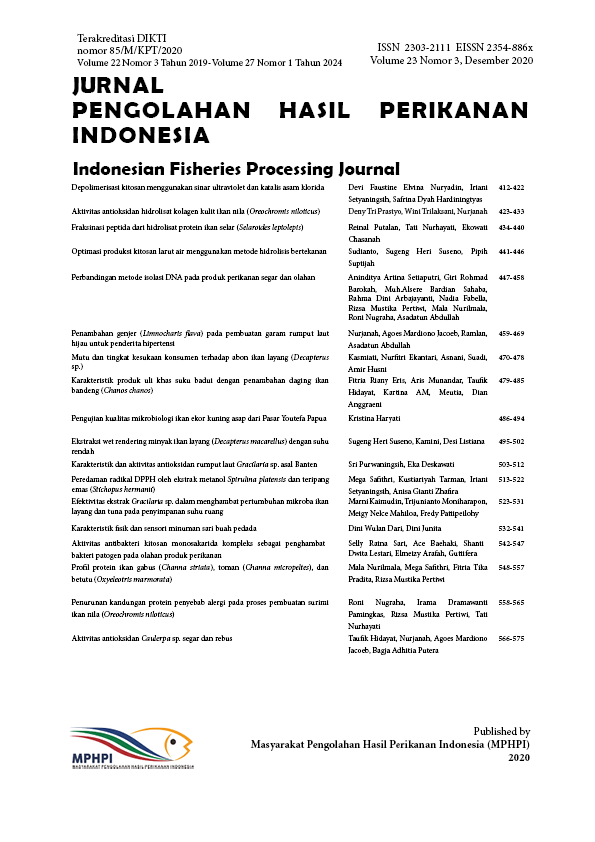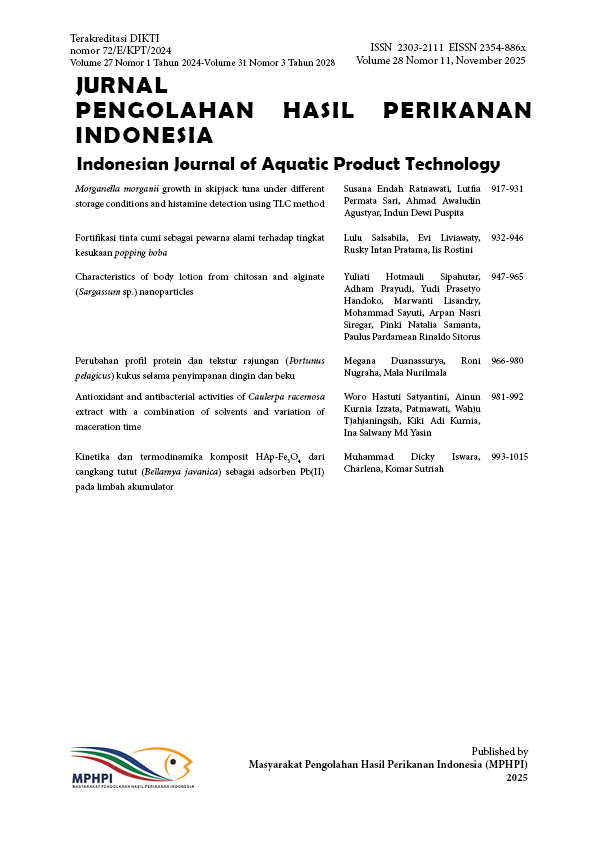Karakteristik Produk Uli Khas Suku Badui dengan Penambahan Daging Ikan Bandeng (Chanos chanos)
Characteristics of Uli as a Typical Product of the Badui Tribe with the Addition of Milkfish Meat (Chanos chanos)
DOI:
https://doi.org/10.17844/jphpi.v23i3.33003Keywords:
local food, organoleptic, protein, uliAbstract
Uli is a local food of the Badui tribe made from sticky rice. Uli has a high carbohydrate content but is low in other types of nutrients. Therefore, to increase the nutritional value, milkfish meat can be added to the Uli. This study was aimed to determine effect of addition of milkfish meat on the chemical, physical, and organoleptic characteristics of the uliThis research includesd the preparation of milkfish, uli production and product characterizationincluding chemical (moisture, ash, protein, and fat), physical (hardness), and organoleptic (taste, color, texture, and aroma). Three concentration of milkfish were added including 0%, 10%, 20%, and 30%. The lowest moisture content of the uli was found at 30% concentration of milkfish with a 49.44% value. The ash content ranged from 1.32 to 3.00%, and the lowest was at concentration of 20%. The highest protein content (9.15%) was found at 20% concentration with value, while the highest levels of fat (8.82%) were at concentration of 20% . The hardness value of uli decreased with the increase in milkfish concentration with values ranging 2,319.59-4,184.85 gf. The organoleptic test results showed that the parameters of taste, color, texture, and aroma were not significant affected, meaning that the addition of milkfish meat was still preferred. Thus, the optimum concentration of milkfish meat added in to the uli product was 20%.
References
Badan Pusat Statistik Provinsi Banten [BPS Provinsi Banten]. 2020. Provinsi Banten dalam Angka. Serang (ID): BPS Provinsi Banten.
Bourne MC. 2002. Food, Texture and Viscosity Concept and Measurement. London (GB): Academic Press.
Badan Standardisasi Nasional [BSN]. 2006. Cara Uji Kimia SNI 01-2354. Jakarta (ID): Badan Standardisasi Nasional Indonesia.
Dinas Kelautan dan Perikanan Provinsi Banten [DKP Provinsi Banten]. 2018. Kelautan dan Perikanan dalam Angka. Serang (ID): Dinas Dinas Kelautan dan Perikanan Provinsi Banten.
Dinas Kelautan dan Perikanan Provinsi Banten [DKP Provinsi Banten]. 2019. Profil Potensi Usaha dan Investasi Komoditas Bandeng di Kabupaten Serang. Jakarta (ID): Kementerian Kelautan dan Perikanan.
Eris FR, Kartina AM, Anggraeni D, dan Mirajiani. 2017. Identifikasi dan Karakterisasi Bahan Pangan Etnis Baduy Berbasis Kearifan Lokal dalam Rangka Mendukung Ketahanan Pangan. [Laporan]. Serang (ID): Universitas Sultan Ageng Tirtayasa.
Handayani DI dan Kartikawati D. 2014. Stik Lele Alternatif Diversifikasi Olahan Lele (Clarias sp) tanpa Limbah Berkalsium Tinggi. Serat Acitya-Jurnal Ilmiah UNTAG.
Hafiluddin, Perwitasari D, dan Budiarto S. 2014. Analisis Kandungan Gizi dan Bau Lumpur Ikan Bandeng (Chanos chanos) dari Dua Lokasi yang Berbeda. Jurnal Kelautan. 7(1): 33-44.
Judith F, Buchari D, dan Sumarto. 2015. Pengaruh Penambahan Daging Ikan Patin (Pangasius hypopthalmus) pada Pengolahan Rengginang Ubi Kayu (Manihot esculenta C) terhadap Penilaian Organoleptik. Jurnal Ilmiah Mahasiswa Unri. 1: 1-10.
Mayyawadee S dan Gerhard S. 2010. Effect of Blending Cassava Starch, Rice, Waxy Rice and Wheat Flour on Physico-Chemical Properties of Flour Mixtures and Mechanical and Sound Emission Properties of Cassava Crackers. Journal of Food Engineering 100: 12–24.
Mufarihat IK, Haryati S, dan Munandar A. 2019. Karakteristik Bontot dengan Kombinasi Daging Ikan Payus (Elops hawaiiensis) dan Ikan Bulan Bulan (Megalops cyprinoides). Jurnal Pengolahan Hasil Perikanan Indonesia. 22(3): 476-482.
Setyaningsih D, Apriyantono A dan Sari MP. 2010. Analisis Sensori untuk Industri Pangan dan Agro. Bogor (ID): IPB Press.
Downloads
Published
Issue
Section
License
Authors who publish with this journal agree to the following terms:
- Authors retain copyright and grant the journal right of first publication with the work simultaneously licensed under a Creative Commons Attribution License that allows others to share the work with an acknowledgement of the work's authorship and initial publication in this journal.
- Authors are able to enter into separate, additional contractual arrangements for the non-exclusive distribution of the journal's published version of the work (e.g., post it to an institutional repository or publish it in a book), with an acknowledgement of its initial publication in this journal.













